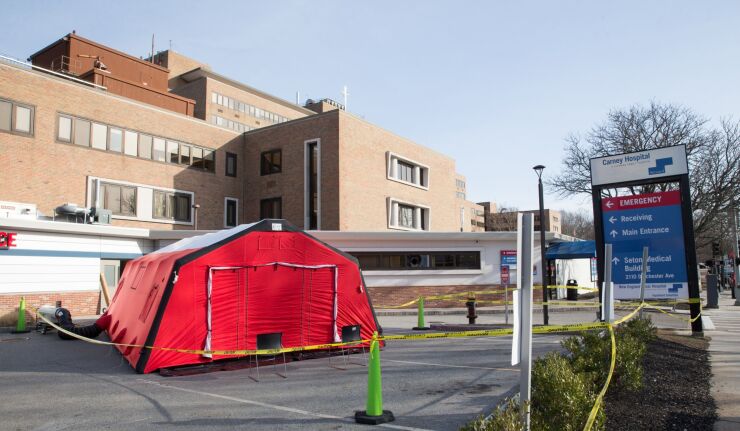The fiscal impact of the COVID-19 pandemic for the healthcare sector poses the dual shock of skyrocketing treatment expenses and the loss of revenue from cancelled services.
“The near and medium impact of the COVID-19 outbreak on the U.S. healthcare sector is expected to be significant, but the degree of impact will vary somewhat depending on subsector. Hospitals are canceling elective/deferrable procedures, which are generally the most profitable segment in their operations, in exchange for performing lower profit treatments for Covid-19 patients,” said Rhett Brown, lead healthcare research analyst at Lazard Asset Management.
“Larger hospitals, and systems, and the higher quality credits” generally “have an ability to withstand this type of short-term stress on the balance sheet,” said George Huang, senior analyst at Wells Fargo. “Days cash on hand is critical.”
Of the nation’s 2,160 rural hospitals about 453 were already “vulnerable” to closure based on operations, according to a recent study from the
Market analysts caution that the scope of the crisis is unprecedented, making any prognosis risky.
Some regions have been hit harder than others by COVID-19 — so far — and local preparation has varied; what level and form of aid the Trump administration and Congress agree to is uncertain.
That all means it hard to assess the potential for near-term credit damage or where healthcare spreads may eventually settle.
“Like most of the market they are trading cheaper” and that extends to single-A and double-A healthcare credits but the sharpest hit is for lower-rated credits with “triple-B hospital spreads having widened considerably,” said Jon Barasch, a director in Municipal Evaluations at Intercontinental Exchange’s ICE Data Services.
Market participants share a consensus on one factor — the near-to-midterm fiscal impact depends a good deal on the nation’s efforts through school and work shut-downs, cancelled sporting events and conventions, self-quarantine recommendations and social distancing to “Flatten the Curve.”
That’s the now
A steep, mountain-like curve represents the peak of a pandemic — without any intervention measures — in which many people get sick at once, overwhelming healthcare providers. A gentler hill-like curve represents a gradual spread as a result of intervention that eases the burden on hospitals.
“We are in the beginning of this so there's no way of predicting. The financial and economic impacts are going to be totally dependent on which one we get,” Ken Kaufman, a longtime advisor to healthcare providers and a founding partner of Kaufman Hall, said of the two curves.
Hospital finance teams are laser-focused on ensuring they have the capacity to cope.
“Finance is on the backburner” as the sector focuses on beds, ventilators, safety equipment, and staffing levels, but it is a reminder of the “significance of liquidity,” Kaufman said.

In an interview Kaufman posted
“I review that every day along with the CFO. We have had millions and millions of dollars of unbudgeted expenses. We track these so that, to the extent the federal government and potentially state government release dollars, we can figure out how to legitimately access those dollars for relief. We have an understanding board,” Murphy said.
A dramatic influx of cases could overwhelm staff, and spread the virus to them, driving rapid spending increases for private help. Expanded temporary facilities are costly with a demand for expensive intensive care equipment, as well as staff protective gear and ventilators now in short supply.
Such a scenario would force hospitals to undertake more extraordinary measures at the same time they've suspended or lost non-emergency elective surgeries, non-emergency physician appointments, and diagnostic testing that fuel the revenue side, Huang said.
One in five COVID-19 cases typically requires hospital care. As of Thursday, it has sickened more than 221,000 people worldwide and killed more than 9.200, according to a
The Aftermath
After the crisis ebbs, the most pressing issue that remains may be the length and depth of the recession it’s triggered, Huang said. Hospitals have already been struggling with threats to the Affordable Care Act, reimbursement rates, and other operating strains.
Advocates are trying to tamp down the balance sheet effects in an expected federal aid package. The rising toll was underscored in the American Hospital Association’s request Thursday to Congress for $100 billion in direct aid to hospitals who are losing $1 million daily. The group previously requested $1 billion.
“Congress needs to assist hospitals, physician practices and other providers on the brink of financial collapse so they are able to make payroll to front line health care personnel and all employees in order to ensure that as many inpatient beds as possible are available during this pandemic,” reads the joint letter from AHA, the American Medical Association and the American Nurses Association.
The Trump administration’s announcement that Navy hospital ships will be deployed to the West and East Coasts and his invocation of the Defense Protection Act if needed to speed production of equipment should help if they pan out, market participants said. A previously declared federal emergency will add flexibility to the Medicaid system to help states cover testing and treatment. Trump also signed the Families First Coronavirus Response Act that raises Medicaid matching funds by 6.2%.
For rating agencies, many factors are in play but days-cash-on-hand and coverage ratios stand out, said Moody’s Investors Service healthcare analyst Lisa Goldstein. Moody’s shifted its outlook on the not-for-profit hospital and healthcare sector to negative from stable Wednesday “as coronavirus accentuates cash flow constraints.” Moody’s rated entities had a median in 2018 of 200.9 days cash on hand with the median total debt to cash flow ratio of 3.1 time and maximum annual debt service coverage ratio of 4.4 times.
Disclosures
Disclosures published in recent offering statements and investor presentations lay out fiscal threats.

The "Bondholders' Risk" section in an offering document for a planned $524 million Stanford Health Care deal discusses COVID-19 in a subsection on infectious disease.
“The treatment of a highly contagious disease at one of SHC’s facilities may result in a temporary shutdown or diversion of patients, harm to workforce personnel, and overburdening of facilities,” the offering statement warns. “In addition unaffected individuals may decide to defer elective procedures or otherwise avoid medical treatment, resulting in reduced patient volumes and operating revenues.
“SHC cannot predict any costs associated with the potential treatment of an infectious disease outbreak or preparation for such treatment. The extent to which business interruption insurance would be available in connection with such events is dependent on specific facts of the events, and there can be no assurance that adequate business interruption insurance would be available to cover losses in such event,” it continued. A viral outbreak is not typically covered by business interruption insurance.
NorthShore University HealthSystem's $435 million sale offering statement warns that “the continued spread of COVID-19 or any other similar outbreaks in the future may materially adversely impact” economies and “may materially adversely impact the financial condition of the credit group.”
Candice Saunders, president and chief executive officer at WellStar Health System in Georgia, discussed COVID-19 in an investor presentation earlier this month as the health system planned to issue $175 million of bonds. "We have established protocols for suspected and confirmed cases of the COVID-19 virus," Saunders said.
WellStar has developed "ongoing readiness" plans developed as a result of previous contagious outbreaks, such as SARS, MERS, Ebola and the Zika virus, she said, adding that the health system has drills, ongoing training, and ensures that personal protection equipment is available. "We feel like we're very well prepared and we are continuing to stay on top of this very emerging health issue," Saunders said.
The Market
Market participants are hard-pressed to issue any long-term pronouncements on yield penalties and spreads for healthcare paper given the market’s overall volatility over the last two weeks.
“The situation is too fluid. We are in unchartered water in all financial markets,” said Daniel Berger, senior market strategist at MMD-Refinitiv.
Big swings continued to mark healthcare paper in the secondary. Decent sized trades were seen Wednesday at lower price levels, said Edward Lee, IHS Markit strategist. A 2044 Common Spirit Health maturity with a 5% coupon traded at a 210 basis point spread to the high-grade scale compared a previous spread of 164 bp.
Wells Fargo is sticking with its strategic recommendation issued as the New Year began to move up in quality to limit risk because there was too little reward for the risks given the tightness of spreads. It has now removed its tactical call to buy munis lower on the credit scale for trading purposes.
Wells Fargo believes it’s prudent now to unwind those tactical trading positions and if investing in the not-for-profit sector to stick with higher-quality credits, Huang said.
Morgan Stanley Research shifted its recommendation to equal-weight from over-weight on the municipal hospital sector in a municipal strategy brief published this week.
“Although financially resilient, the risk of operational stress is not in the price,” the team said. “We tactically reduce exposure to single-facilities & credits with low cash on hand” while suggesting adding “to multi-state systems & children's names if spreads widen.”
The recommendation stems from the risks posed by operational stresses, headlines, and further outflows from credit-focused funds that Morgan Stanley doesn’t believe is reflected in current prices.
While headline risk is likely and credit erosion possible Morgan Stanley said it doesn’t think the event introduces “widespread default risk.”
Federal Help
An AHA letter earlier this week urges Congress to provide financial assistance for hospitals making infrastructure investments, as well as for the purchase of equipment and supplies necessary to combat the COVID-19 pandemic. The AHA also urges Congress to offset the costs of uncompensated care, bad debt and charity care for treating coronavirus patients through a full payroll tax credit or other policy mechanism.
“Legislation that recognizes and helps mitigate these additional costs is an essential component to maintaining hospital financial viability,” AHA executive vice president for government relations and public policy Thomas Nickels wrote. AHA represents 5,000 member hospitals, health systems and other organizations.
AHA also asks Congress to pass legislation that restores advance refundings to free up “billions of dollars that governments and hospitals could devote to meeting the urgent needs of this crisis” and raises the limit to $30 million from $10 million on bank-qualified borrowing and having it apply at the borrower level which would benefit “thousands of small issuers, and governmental and nonprofit borrowers.
“We are watching the news unfold on an hourly basis” and there’s lots of factors that could influence credit profiles, Moody’s Goldstein said.
There’s both the impact of treating coronavirus and the ripple effect as hospitals without any cases are still cancelling elective procedures in potential preparation, Goldstein said. “We are looking at urban areas, safety nets, high Medicare” reliant facilities and bond covenants on debt service and days cash on hand.
“We are watching to see how close they might get to a violation,” Goldstein said. Hospitals and systems with thinner margins have little breathing room to incur higher expenses while losing revenue.
Some will have a cushion from liquidity or lengthier timelines on triggers. Short-term debt risks could also increase from market disruptions. Hospitals with self-liquidity or bank-supported debt could see more tenders and materially higher interest rates.
“We expect the majority of our rated portfolio to be able to withstand a temporary” impact, Goldstein said. Many higher rated entities also benefit from liquid investments that can be tapped quickly to cope with COVID-19 treatment demands.
The sector will likely see lower cash flow compared to 2019. The baseline assumption is some containment of the outbreak will occur in the second half and the economy will gradually recover but even if that holds the effects will linger with a reduction in hospitals' investment portfolios and potential rising unemployment or layoffs that result in the loss of health benefits.
“Hospitals will see an increase in patient visits, which could provide an uptick in revenues in the short-run,” said Kroll Bond Rating Agency analyst Kate Kennedy. “Swift and efficient state and federal collaboration to provide infrastructure and financial relief to hospitals is critically important.”
S&P Global Ratings said it’s watching to gauge how hospitals manage the demand and their capacity to treat these patients as well as having the appropriate resources to manage overall care in a more stressed delivery system. “A longer-term situation could cause rating pressure to certain hospitals that may already be in a challenged operating situation or should the recessionary and economic pressures negatively affect providers' balance sheets," S&P said in a March 5 report.
“The situation continues to be extremely fluid at the moment,” said Fitch healthcare analyst Kevin Holloran. “We think most of our highly rated credits will survive this surge, but we are concerned about lower-rated credits, particularly those that are single-site, with light liquidity in areas with high 65-plus and over population. We are most concerned about longer term credit effects” such as a hospital's ability to handle additional shocks and economic fallout.
The postponement of elective procedures because of hospital or patient choice, considered alone, would depress a hospital's revenues. The biggest financial concern for hospitals with COVID-19 is labor. Staffing is hospitals' biggest expense and some will be furloughed because of exposure, Holloran said. “The hospitals will have to pay that in the form of overtime pay, payments to outside agencies, and payments to people to come out of retirement. However, this will only be temporary and so shouldn't be a significant financial issue for most hospitals,” Holloran said.
American Epicenter
New York, with four times as many confirmed cases as any other state, is acting to aid hospitals as it grapples with the highest level of cases among states.
The city will create approximately 1,300 hospital beds through the conversion of four buildings into temporary hospital space that includes NYC Health + Hospitals/Coler, a rehabilitation facility on Roosevelt Island, a nursing home facility in the East New York neighborhood of Brooklyn, Westchester Square Hospital in the Bronx and North Central Bronx Hospital, Mayor Bill de Blasio announced.
The city will also take over space in five small hotels, freeing up 250 hotel rooms to be converted into hospital facilities. Eleven tents have also been purchased to be converted into temporary facilities, and the city has placed an order for an additional 10-20 tents, as well.
Gov. Andrew Cuomo expects the virus should peak in 45 days and warned with 53,000 beds now the city may need more than 50,000 more. Projections warn of a need for up to 37,000 ventilators with only 3,000 now available. The state is also asking current and reserve staff calling for retired nurses and doctors help.
— Written by Yvette Shields and Robert Slavin. Paul Burton, Shelly Sigo, Brian Tumulty contributed to this story.






